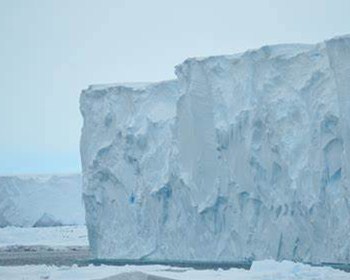Throughout all this the tubeworms and clams and other life forms adhering to deep ocean vents undoubtedly went on as if nothing were amiss, but all other life on Earth probably came as close as it ever has to checking out entirely. It was all a long time ago and at this stage we just don't know.
這一時(shí)期,多毛蟲、蛤蜊,以及其他附著于深海噴氣孔的生命無疑繼續(xù)存在,仿佛什么事兒也沒有。而地球上所有其他生命很可能到了完全滅絕的邊緣。這一時(shí)期距我們今天十分遙遠(yuǎn),而我們目前對(duì)它的了解是極其匱乏的。
Compared with a Cryogenian outburst, the ice ages of more recent times seem pretty small scale, but of course they were immensely grand by the standards of anything to be found on Earth today. The Wisconsian ice sheet, which covered much of Europe and North America, was two miles thick in places and marched forward at a rate of about four hundred feet a year. What a thing it must have been to behold. Even at their leading edge, the ice sheets could be nearly half a mile thick. Imagine standing at the base of a wall of ice two thousand feet high. Behind this edge, over an area measuring in the millions of square miles, would be nothing but more ice, with only a few of the tallest mountain summits poking through. Whole continents sagged under the weight of so much ice and even now, twelve thousand years after the glaciers' withdrawal, are still rising back into place. The ice sheets didn't just dribble out boulders and long lines of gravelly moraines, but dumped entire landmasses—Long Island and Cape Cod and Nantucket, among others—as they slowly swept along. It's little wonder that geologists before Agassiz had trouble grasping their monumental capacity to rework landscapes.
與覆冰紀(jì)大爆發(fā)時(shí)代相比,最近幾次冰川期的規(guī)模似乎要小得多,但以今天地球上的任何標(biāo)準(zhǔn)來衡量,它還是極其巨大的。覆蓋歐洲和北美洲的威斯康星冰蓋在某些地方厚達(dá)3公里,并且還以每年120米的速度不斷前進(jìn)。即使在其邊緣地段,冰蓋也差不多有800米厚。這是—個(gè)多么壯觀的景象啊!想像一下,你站在一堵那么高的冰墻腳下,墻的后面是幾百萬平方公里的地方,除了幾座刺向青天的冰峰,全都是一望無際的冰蓋。整塊整塊的陸地在巨大的冰蓋的壓力下沉降,即使在荊”退卻12000年后的今天,這些陸地還沒有上升到原來的位置。在冰蓋緩慢移動(dòng)的過程中,不僅使巨大的石塊和冰磧石堆改變了位置,而且還扔下整塊整塊的陸地——諸如長(zhǎng)島、科德角、楠塔基特島等等。阿加西斯以前的地質(zhì)學(xué)家難以,理解冰蓋所具有的足以使地球表面發(fā)生變化的巨大的威力,這是不足為怪的。
 If ice sheets advanced again, we have nothing in our armory that could deflect them. In 1964, at Prince William Sound in Alaska, one of the largest glacial fields in North America was hit by the strongest earthquake ever recorded on the continent. It measured 9.2 on the Richter scale. Along the fault line, the land rose by as much as twenty feet. The quake was so violent, in fact, that it made water slosh out of pools in Texas. And what effect did this unparalleled outburst have on the glaciers of Prince William Sound? None at all. They just soaked it up and kept on moving.
If ice sheets advanced again, we have nothing in our armory that could deflect them. In 1964, at Prince William Sound in Alaska, one of the largest glacial fields in North America was hit by the strongest earthquake ever recorded on the continent. It measured 9.2 on the Richter scale. Along the fault line, the land rose by as much as twenty feet. The quake was so violent, in fact, that it made water slosh out of pools in Texas. And what effect did this unparalleled outburst have on the glaciers of Prince William Sound? None at all. They just soaked it up and kept on moving.
如果冰蓋卷土重來,我們沒有任何武器可以改變它們的方向。1964年,在阿拉斯加威廉王子灣,北美最大的冰川地區(qū)發(fā)生該大陸有記錄以來最強(qiáng)烈的地震,其強(qiáng)度達(dá)里氏9.2級(jí)。在發(fā)生斷層韻地方,地表上升了6米,這次地震是如此的強(qiáng)烈,連德克薩斯州的池塘水都濺到了岸上。但是,這次前所謂有的震動(dòng)對(duì)于威廉王子灣的冰川產(chǎn)生了怎么樣的影響呢?根本沒有,冰川抵消了地震,繼續(xù)其前進(jìn)的步伐。
 If ice sheets advanced again, we have nothing in our armory that could deflect them. In 1964, at Prince William Sound in Alaska, one of the largest glacial fields in North America was hit by the strongest earthquake ever recorded on the continent. It measured 9.2 on the Richter scale. Along the fault line, the land rose by as much as twenty feet. The quake was so violent, in fact, that it made water slosh out of pools in Texas. And what effect did this unparalleled outburst have on the glaciers of Prince William Sound? None at all. They just soaked it up and kept on moving.
If ice sheets advanced again, we have nothing in our armory that could deflect them. In 1964, at Prince William Sound in Alaska, one of the largest glacial fields in North America was hit by the strongest earthquake ever recorded on the continent. It measured 9.2 on the Richter scale. Along the fault line, the land rose by as much as twenty feet. The quake was so violent, in fact, that it made water slosh out of pools in Texas. And what effect did this unparalleled outburst have on the glaciers of Prince William Sound? None at all. They just soaked it up and kept on moving.










